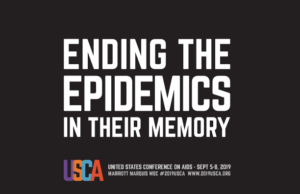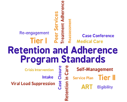 Last week CDC released funding announcement PS19-1906 for the 57 jurisdictions to accelerate HIV planning to end the HIV epidemic. The biggest challenge will be time. Responses are due in 30 days and local plans to end the epidemic are needed by the end of the year.
Last week CDC released funding announcement PS19-1906 for the 57 jurisdictions to accelerate HIV planning to end the HIV epidemic. The biggest challenge will be time. Responses are due in 30 days and local plans to end the epidemic are needed by the end of the year.
While the announcement is restricted to select jurisdictions, NMAC hopes everyone working to end the epidemic will read the announcement because it outlines the values and principles for the federal effort. Component A was clearly written for NASTAD and Component B was written for 32 health departments that are eligible to apply for this funding. While 57 jurisdictions are targeted, only 32 awards will be made because funding is going to state health departments who will trickle down the support to the targeted counties.
 NMAC wonders why Ryan White Part A jurisdictions were not used to support this effort. We are concerned that in some states, there are no funding relationships between the state health department and the jurisdiction being targeted. It will take time and money to set up these systems when HRSA already has funding relationships with 56 of the 57 jurisdictions. It should also be noted that some state health departments may not have the infrastructure to put together their jurisdictional plan. NMAC supports subcontracts to community-based organizations to lead these tasks. In Florida, the health department is considering contracting with the AIDS Institute. We support this innovation because the learning curve is too steep if you don’t have HIV programs or the infrastructure to manage this effort.
NMAC wonders why Ryan White Part A jurisdictions were not used to support this effort. We are concerned that in some states, there are no funding relationships between the state health department and the jurisdiction being targeted. It will take time and money to set up these systems when HRSA already has funding relationships with 56 of the 57 jurisdictions. It should also be noted that some state health departments may not have the infrastructure to put together their jurisdictional plan. NMAC supports subcontracts to community-based organizations to lead these tasks. In Florida, the health department is considering contracting with the AIDS Institute. We support this innovation because the learning curve is too steep if you don’t have HIV programs or the infrastructure to manage this effort.
 Some of the jurisdictions have already completed their planning. Peer to peer learning means communities do not have to reinvent the wheel. NMAC is working with AIDS United, NASTAD, NSCD and the AIDS Institute to scholarship all 57 jurisdictions to this year’s United States Conference on AIDS. Our goal is to bring national, federal, and local leaders together to discuss how to build comprehensive local plans.
Some of the jurisdictions have already completed their planning. Peer to peer learning means communities do not have to reinvent the wheel. NMAC is working with AIDS United, NASTAD, NSCD and the AIDS Institute to scholarship all 57 jurisdictions to this year’s United States Conference on AIDS. Our goal is to bring national, federal, and local leaders together to discuss how to build comprehensive local plans.
PS10-1906 will be funded by September 30, 2019. The 57 jurisdictions will be asked to turn around their plans to end the epidemic in the next 60-90 days. The short turn-around time is necessary because the HHS 2021 budget request needs to be at the White House by the end of 2019. We’ve been told HHS will ask for up to one billion dollars in new funding to support the initiatives prioritized in the 57 jurisdictional plans. In other words, your plans are really important.
 The Partnership to End the Epidemics wants to support health departments to put together their plans. At the meeting with the 57 jurisdictions, we will discuss ways our national organizations can support your efforts. NMAC believes that our ability to address race and HIV will be core to our efforts to end the epidemic. If you need support putting together either your response to PS10-1906 or your plan to end the epidemic, please contact Linda H. Scruggs, the director of the NMAC Training Center to End the HIV Epidemic.
The Partnership to End the Epidemics wants to support health departments to put together their plans. At the meeting with the 57 jurisdictions, we will discuss ways our national organizations can support your efforts. NMAC believes that our ability to address race and HIV will be core to our efforts to end the epidemic. If you need support putting together either your response to PS10-1906 or your plan to end the epidemic, please contact Linda H. Scruggs, the director of the NMAC Training Center to End the HIV Epidemic.
 Effective plans must speak to the 400,000 PLWH who have fallen out of care or are unaware of their HIV status and the 1.1 million people the plan hopes to retain on PrEP. Retention in healthcare and adherence to meds it not simply a matter of seeing a doctor and getting a prescription. If it was that easy, we would have already ended HIV. Our efforts need to reach some of the most marginalized in America. Too many people over 50 living with HIV suffer from isolation that leads to depression. If our work is limited to linkages to healthcare and access to meds, we will miss the target. What does it take to help someone who suffers from post-traumatic stress because they are a transgender person of color living with HIV who is homeless and does sex work to survive? That is the reality for too many that we need to reach.
Effective plans must speak to the 400,000 PLWH who have fallen out of care or are unaware of their HIV status and the 1.1 million people the plan hopes to retain on PrEP. Retention in healthcare and adherence to meds it not simply a matter of seeing a doctor and getting a prescription. If it was that easy, we would have already ended HIV. Our efforts need to reach some of the most marginalized in America. Too many people over 50 living with HIV suffer from isolation that leads to depression. If our work is limited to linkages to healthcare and access to meds, we will miss the target. What does it take to help someone who suffers from post-traumatic stress because they are a transgender person of color living with HIV who is homeless and does sex work to survive? That is the reality for too many that we need to reach.
 For community members in targeted jurisdictions, now is the time to work with your health department to put together the application and the local plan to end the epidemic. You may need to fight for a seat at the table. Build coalitions with other communities highly impacted by HIV to ensure that your mutual issues are prioritized. These plans need to reach communities that have eluded previous efforts. There must be people living with HIV, people of color, gay men, the transgender community, women, people on PrEP, and former drug users at the table. Health departments need to understand that many marginalized communities do not have experience sitting on planning bodies. They will need technical assistance and support to be part of the process.
For community members in targeted jurisdictions, now is the time to work with your health department to put together the application and the local plan to end the epidemic. You may need to fight for a seat at the table. Build coalitions with other communities highly impacted by HIV to ensure that your mutual issues are prioritized. These plans need to reach communities that have eluded previous efforts. There must be people living with HIV, people of color, gay men, the transgender community, women, people on PrEP, and former drug users at the table. Health departments need to understand that many marginalized communities do not have experience sitting on planning bodies. They will need technical assistance and support to be part of the process.
 We are making history as we work to end an epidemic without a vaccine or a cure. NMAC desperately wants you to succeed. We are not just building pathways to ending an epidemic, we are also learning how to reach communities that are far too often overlooked and underserved. Thank you for making the impossible possible.
We are making history as we work to end an epidemic without a vaccine or a cure. NMAC desperately wants you to succeed. We are not just building pathways to ending an epidemic, we are also learning how to reach communities that are far too often overlooked and underserved. Thank you for making the impossible possible.
Yours in the struggle,
Paul Kawata
30 Years of Service
